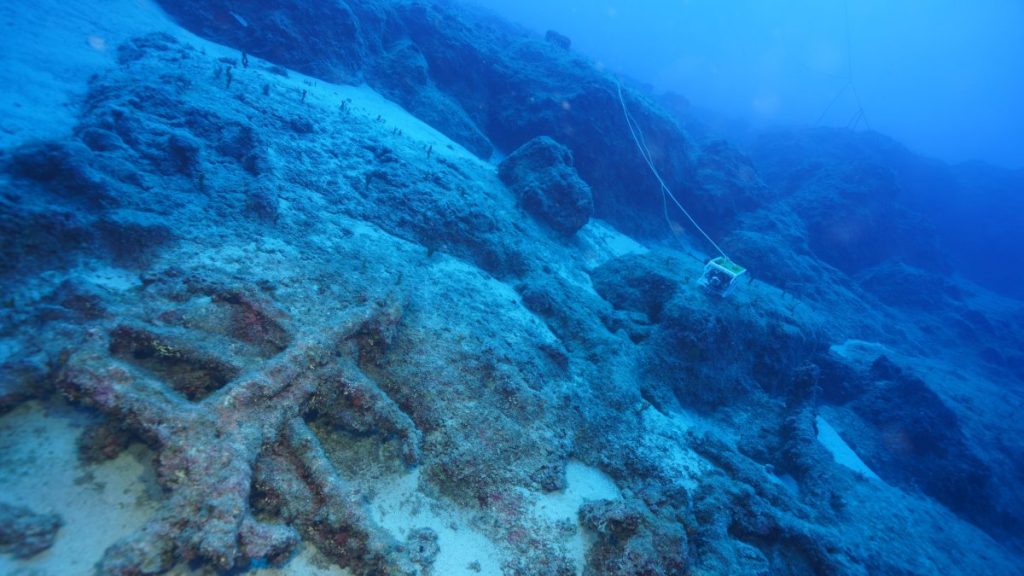Underwater excavations carried out with the help of robots off the coast of Antalya’s Kaş district, southwestern Türkiye, have unearthed a sealed, 1,000-year-old amphora (an ancient type of storage jar), exciting archaeologists.
Hakan Öniz, head of the Department of Cultural Heritage Conservation and Restoration at the Faculty of Fine Arts of Akdeniz University and the scientific advisor for the excavation, along with a 20-person diving team, are conducting the underwater excavations in the Mediterranean.
The team, working on behalf of Antalya Museum as part of the Ministry of Culture and Tourism’s “Legacy for the Future Project,” carried out the excavation with the assistance of robots at a depth of several meters off Besmi Island, in Kaş.
As a result of the meticulous excavation, the team succeeded in retrieving the sealed amphora from a shipwreck located at a depth of about 45-50 meters (around 135 feet), which caused great excitement.
After undergoing several stages before being brought ashore, the amphora was transported to the Underwater Archaeology Laboratory at Akdeniz University in Kemer, where it was first examined under a microscope and with special magnifying glasses. Following that, experts from the Antalya Regional Board and lab restorers carefully opened the amphora’s seal using chisels, hammers and small tools, in a process that lasted about an hour.
Experts began analyzing the samples from inside the amphora to determine what the contents were.
The scientists had an intense moment when the amphora was opened, closely examining the texture, contents and smell to try to identify what it contained.
Öniz, head of the excavation team, told Anadolu Agency (AA) that they suspect the trade ship, which had left the coast of Gaza in Palestine about 1,100 years ago, sank along the Mediterranean coast likely due to a storm.
He explained that olive oil was a key export product for Gaza at the time, and wine was likely exported from Tekirdağ Şarköy-Gaziköy. He noted: “This trade ship visited multiple ports. It dates back to the period of Abbasid rule in the ninth and 10th centuries, during Islamic rule.”
Looking at the amphorae that likely contained wine, he remarked: “We don’t think the locals in Palestine consumed wine. However, it might have been goods sent to immigrants, Christian pilgrims, or people visiting Jerusalem as gifts.”
He emphasized the rarity of the situation, stating, “The fact that the amphora’s seal has been closed for over a thousand years is unique. It could contain olive pits, olive oil, wine or fish sauce, but it might also be something completely different.”
He continued: “It is genuinely an exciting process because it’s a sealed amphora. After 1,100 years, the amphora’s seal was opened, and what’s inside will be revealed after the analysis process. The opening was exciting, but the outcome will be even more thrilling.”
Professor Meltem Asiltürk Ersoy, from the Department of Materials Science and Engineering at Akdeniz University, shared that this was the first time in her career that she would analyze the contents of a sealed amphora. She observed the muddy samples inside and explained, “Considering the 1,100-year period in the marine environment, under pressure and temperature changes, we will try to understand what happened to the contents.”
She added: “Scientific studies do not rely on a single analysis; many analyses need to verify each other. Therefore, this process will take time. We will combine the results of the analysis with the information from that period and present the results to the world of science and archaeology.”
Restorer conservator Rabia Nur Akyüz, who handled the desalination and the opening of the amphora’s seal, detailed their careful work. “We made sure to keep the amphora continuously wet to prevent the formations on it from drying out.”


